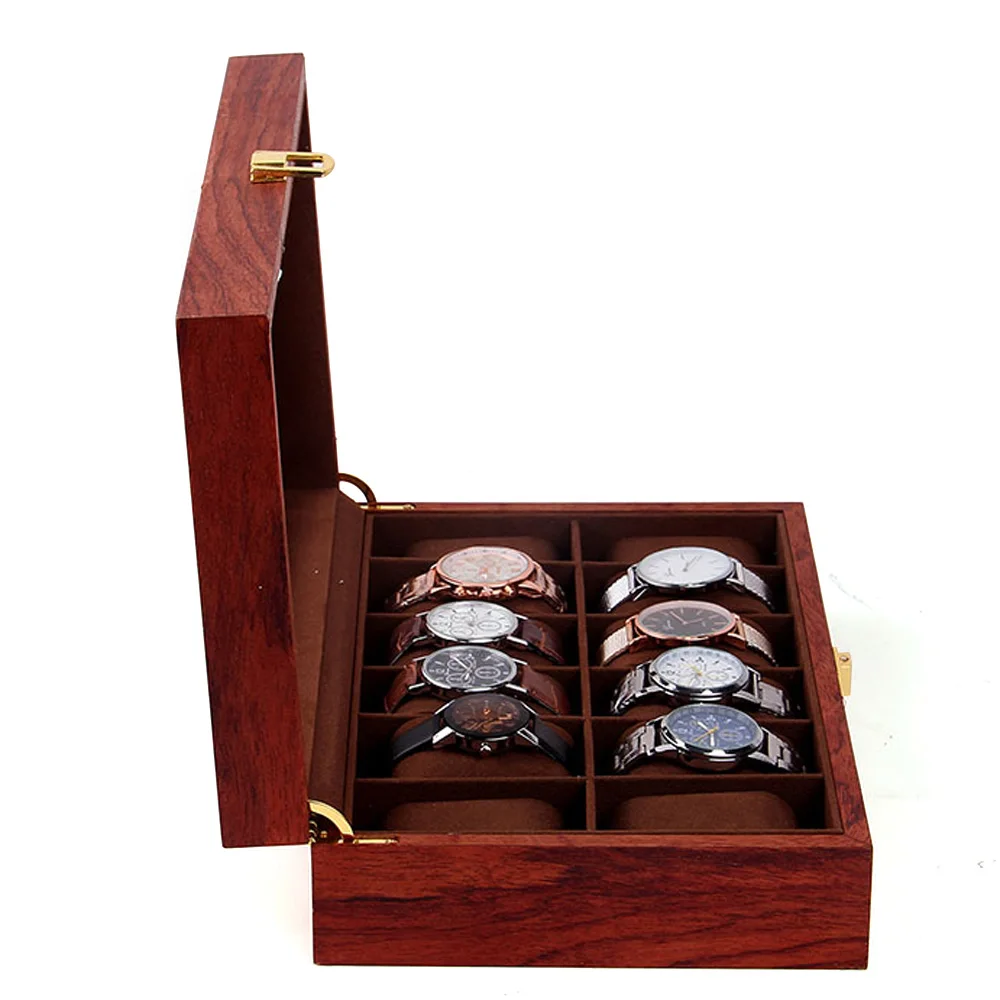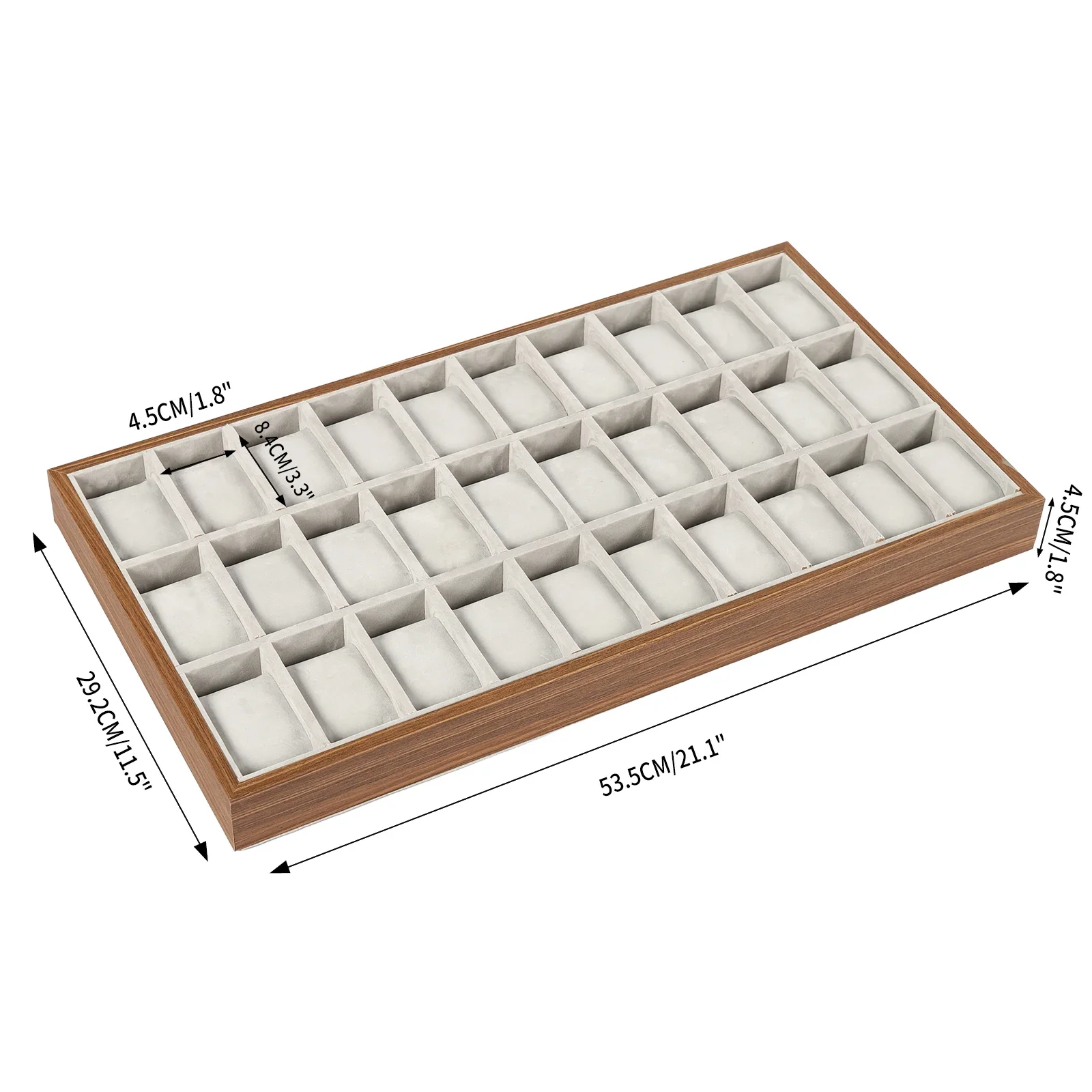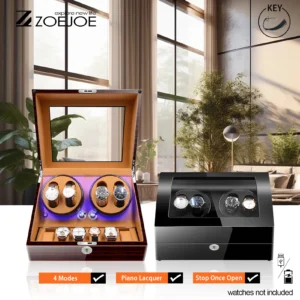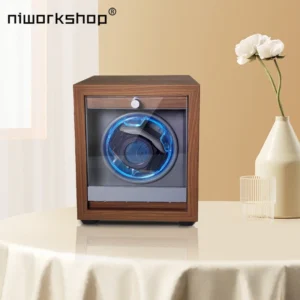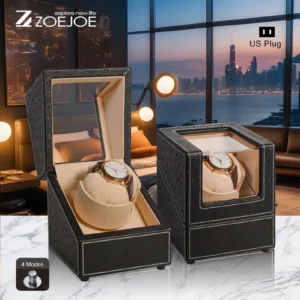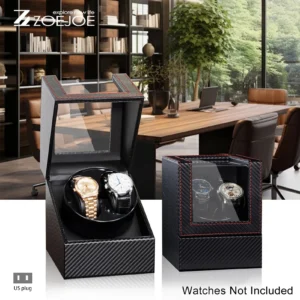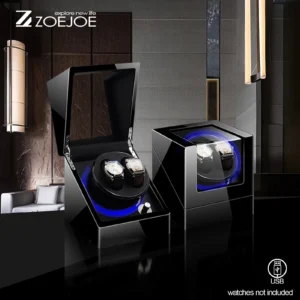Understanding Automatic Watch Winders and Rotation Cycles
For watch enthusiasts who own automatic timepieces, an automatic watch winder is more than just an accessory—it’s an essential tool for maintaining the longevity and accuracy of your investment. Automatic watches are mechanical marvels that wind themselves through the natural movement of your wrist throughout the day. When not worn, these timepieces eventually stop as their mainspring unwinds, requiring reset and adjustment when you decide to wear them again.
This is where watch winders come in. These devices simulate the natural motion of your wrist, keeping your automatic watch running even when it’s not on your wrist. They perform this function through carefully calibrated rotation cycles that mimic the movement patterns your watch would experience during normal wear.
The foundation of any watch winder’s functionality is based on a measurement called “Turns Per Day” (TPD). This refers to the number of complete rotations the winder makes in a 24-hour period. Getting this setting right is crucial—too few rotations and your watch won’t maintain enough power to keep accurate time; too many and you risk causing unnecessary wear on the movement’s components.
Automatic watch winders serve multiple purposes beyond simply keeping your timepiece running. They help maintain proper lubrication distribution throughout the movement, ensure that complicated functions like date displays and moon phases operate correctly, and eliminate the inconvenience of having to reset your watch after it stops.
Throughout this guide, we’ll explore how to determine the perfect rotation settings for your specific timepiece, understand the science behind TPD requirements, and learn how to troubleshoot common issues that may arise with watch winders. With the right knowledge, you can ensure your prized timepiece remains in optimal condition whether you’re wearing it or not.
Key Components of Watch Winder Settings
To properly maintain your automatic timepiece, understanding the key components of watch winder settings is essential. These settings directly affect how well your watch maintains accuracy and longevity while not being worn.
Understanding TPD (Turns Per Day)
TPD is the fundamental measurement for watch winder settings, referring to the number of complete 360-degree rotations your watch will experience in a 24-hour period. Most automatic watches require between 650-950 TPD to maintain optimal power reserve. This range simulates the average amount of movement your watch would receive during normal daily wear.
Think of TPD as your watch’s daily exercise routine—each watch has specific needs based on its internal design. Setting the correct TPD ensures your watch receives just the right amount of winding, neither too much nor too little.
Rotation Directions Matter
Equally important to TPD is the direction of rotation. Watch winders typically offer three directional settings:
- Clockwise (CW): The winder rotates in a clockwise direction only
- Counterclockwise (CCW): The winder rotates in a counterclockwise direction only
- Bidirectional: The winder alternates between clockwise and counterclockwise rotations
Different watch movements are engineered to wind in specific directions. For example, many Swiss movements wind bidirectionally, while some Japanese movements might wind most efficiently in a single direction. Using the wrong direction setting could result in inefficient winding or even no winding at all.
The Importance of Intermittent Rotation
Quality single watch winders don’t rotate continuously throughout the day. Instead, they use intermittent rotation cycles—periods of movement followed by rest periods. This pattern more accurately mimics natural wear patterns, where your arm isn’t in constant motion throughout the day.
For example, a winder might rotate for 2 minutes, then rest for 8 minutes before starting again. This intermittent rotation provides several benefits:
- It prevents excess strain on the movement
- It more closely simulates natural wear patterns
- It extends the life of both your watch and the winder motor
- It prevents overwinding (though most modern automatic watches have safeguards against this)
When organizing your watch collection based on winding needs, it’s helpful to group watches with similar TPD requirements. This is particularly useful if you own multiple timepieces but limited winders. Understanding the specific requirements of each watch in your collection allows you to rotate them efficiently through your winder system.
By mastering these key components, you’ll be able to select the perfect settings to keep your timepieces running optimally while preserving their mechanical integrity for years to come.
The Science of TPD: Finding Your Watch’s Sweet Spot
Every automatic watch has an optimal winding range—what enthusiasts often call the “sweet spot.” This is the ideal amount of rotation that keeps your watch powered without causing unnecessary wear. Finding this balance requires understanding several key factors that influence your watch’s winding needs.
The Consequences of Incorrect TPD Settings
When a watch receives insufficient turns per day, it simply won’t maintain its power reserve. You might notice your watch stopping overnight or losing significant time despite being on the winder. This defeats the purpose of having a winder in the first place and requires you to manually reset your timepiece.
Conversely, excessive TPD doesn’t typically “overwind” modern automatic watches (thanks to slipping mainsprings or clutch mechanisms), but it does create unnecessary wear on the movement. Components like the automatic winding mechanism, mainspring, and gear train experience additional friction and stress when constantly in motion. Over time, this can accelerate the need for servicing and potentially shorten your watch’s lifespan.
Factors That Influence TPD Requirements
Several variables determine how many turns per day your specific watch needs:
1. Movement Type and Design
The internal construction of your watch movement significantly impacts its winding requirements. For instance:
– Modern high-efficiency movements often require fewer TPD than older designs
– Movements with higher beat rates may need more consistent winding
– Some movements are designed with unidirectional winding, while others wind bidirectionally
2. Power Reserve Capacity
Watches with longer power reserves (40+ hours) generally require fewer daily rotations to stay fully wound compared to those with shorter reserves (30-36 hours). The power reserve directly relates to mainspring size and energy storage capacity.
3. Age and Service Condition
As watches age, their winding efficiency can change:
– Newly serviced watches typically wind more efficiently
– Older watches with aging lubricants might require more TPD
– Watches due for service may wind inconsistently regardless of TPD settings
4. Wearing Habits
How you integrate the winder into your wearing schedule matters:
– Watches worn daily and placed on winders only overnight need minimal TPD
– Watches in long-term storage require more precise TPD settings
– Rotating collection pieces need settings optimized for their specific storage duration
Understanding these factors helps explain why automatic watch winder programming settings can vary significantly between apparently similar timepieces. Even two watches from the same brand might have different winding needs based on their specific movement calibers.
The key to finding your watch’s sweet spot is to start conservative and make incremental adjustments while monitoring your watch’s performance. Too many collectors make the mistake of defaulting to the highest TPD setting, thinking “more is better,” when in reality, the minimum effective setting is often optimal for long-term watch health.
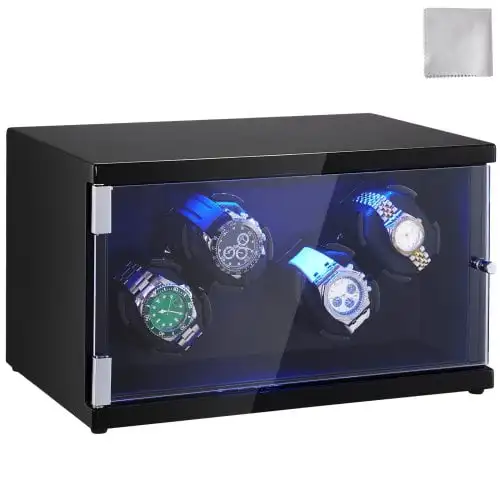
How to Determine the Perfect Rotation Settings for Your Watch
Finding the ideal rotation settings for your specific timepiece requires a methodical approach. Here are three reliable methods to determine the optimal settings for your automatic watch, ranked from most straightforward to most hands-on.
Method 1: Consult Manufacturer Documentation
The most accurate source for rotation information is directly from the watchmaker:
- Check your watch’s original manual for TPD recommendations
- Visit the manufacturer’s website where technical specifications are often listed
- Contact customer service with your specific watch model number
- Look for the movement caliber number (usually found on the caseback or in documentation) and research its specific requirements
Many luxury brands like Rolex, Omega, and Breitling provide explicit guidance on winder settings to ensure their timepieces remain in optimal condition.
Method 2: Use Online TPD Databases
Several reliable online resources compile TPD settings for thousands of watch models:
- Search for “watch winder settings database” or your specific watch brand + “TPD requirements”
- Cross-reference information from multiple sources to ensure accuracy
- Look for forums where collectors share their experiences with specific models
- Pay attention to both TPD numbers and rotation direction recommendations
These databases can be particularly helpful for vintage watches or discontinued models where original documentation may be unavailable.
Method 3: The Experimentation Method
When definitive information isn’t available, this systematic approach helps determine optimal settings:
- Start with manual winding: Fully wind your watch by hand (typically 20-40 crown turns)
- Place on winder with conservative settings: Begin with 650 TPD bidirectional
- Monitor for 24-48 hours: Check if the watch maintains accurate time
- Adjust incrementally: If the watch loses time, increase TPD by 100-150 turns
- Find the minimum effective setting: The ideal TPD is the lowest setting that keeps your watch running accurately
- Test rotation directions: If bidirectional works well, you can try CW or CCW to see if one direction is more efficient
This process may take several days of observation and adjustment, but it ensures you find precisely the right setting for your specific timepiece.
Luxury watch winders often come with a wide range of programmable settings, making this experimentation process much easier. Higher-end models may feature incremental TPD adjustments in steps of 50 or 100 turns, allowing for more precise customization.
For collectors with multiple timepieces, watch storage ideas for collectors often include organizing watches based on their winding needs. Grouping watches with similar TPD requirements makes it easier to rotate them through your winder system efficiently.
Remember that finding the perfect rotation setting is an investment in your watch’s longevity. Taking the time to determine the optimal settings now will help preserve your timepiece’s accuracy and mechanical health for years to come.
Comprehensive Brand-Specific TPD and Direction Guide
Different watch brands and movements have specific rotation requirements to maintain optimal performance. This comprehensive guide provides recommended settings for popular watch brands and movement types. Use these as starting points, recognizing that individual models may have unique requirements.
Luxury Watch Brands
| Brand | Movement Type | Recommended TPD | Direction |
|---|---|---|---|
| Rolex | Modern Calibers (3135, 3235) | 650-750 | Bidirectional |
| Rolex | Older Calibers (3035, 1570) | 750-850 | Bidirectional |
| Omega | Co-Axial Movements | 650-800 | Bidirectional |
| Omega | Traditional Movements | 750-850 | Bidirectional |
| Breitling | B01, B04 Movements | 650-800 | Bidirectional |
| Breitling | Modified ETA Movements | 750-800 | Bidirectional |
| TAG Heuer | Heuer 01, 02 | 800-900 | Bidirectional |
| TAG Heuer | Calibre 5 (ETA-based) | 750-800 | Bidirectional |
| Patek Philippe | All Movements | 800 | Bidirectional |
| Audemars Piguet | Most Movements | 800-850 | Bidirectional |
| IWC | Pellaton Winding System | 750-850 | Bidirectional |
| Jaeger-LeCoultre | Most Movements | 800-900 | Bidirectional |
Mid-Tier Watch Brands
| Brand | Movement Type | Recommended TPD | Direction |
|---|---|---|---|
| Seiko | 6R15, 6R35 | 650-750 | Bidirectional |
| Seiko | 4R35, 4R36 | 650-800 | Bidirectional |
| Tissot | Powermatic 80 | 700-800 | Bidirectional |
| Hamilton | H-10, H-30 | 650-750 | Bidirectional |
| Longines | L888 | 650-800 | Bidirectional |
| Oris | Sellita-Based | 750-850 | Bidirectional |
| Tudor | MT56XX Series | 650-750 | Bidirectional |
| Sinn | ETA/Sellita Based | 750-800 | Bidirectional |
| Mido | Caliber 80 | 700-800 | Bidirectional |
Common Movement Manufacturers
| Movement Type | Recommended TPD | Direction |
|---|---|---|
| ETA 2824-2 | 750-800 | Bidirectional |
| ETA 2892-A2 | 750-800 | Bidirectional |
| Sellita SW200 | 750-800 | Bidirectional |
| Sellita SW300 | 750-800 | Bidirectional |
| Miyota 9015 | 650-850 | Clockwise |
| Miyota 8215 | 650-850 | Clockwise |
| Seiko NH35/NH36 | 650-800 | Bidirectional |
| ETA 7750 (Chronograph) | 800-900 | Bidirectional |
| Valjoux 7750 (Chronograph) | 800-900 | Bidirectional |
When comparing types of watch storage, remember that watches with similar winding requirements can often share winder settings. This can be particularly useful for collectors who rotate pieces through a limited number of winders.
Special considerations:
- Vintage watches generally benefit from lower TPD settings (500-700) to reduce stress on aging components
- Watches with extensive complications (perpetual calendars, moon phases) often need consistent winding to maintain functionality
- Some movements with specialized winding mechanisms may have unique requirements not covered in this general guide
Always verify your specific model’s requirements whenever possible, as manufacturers occasionally update movement specifications. These recommendations provide a solid starting point for most collectors while balancing winding efficiency with long-term movement care.
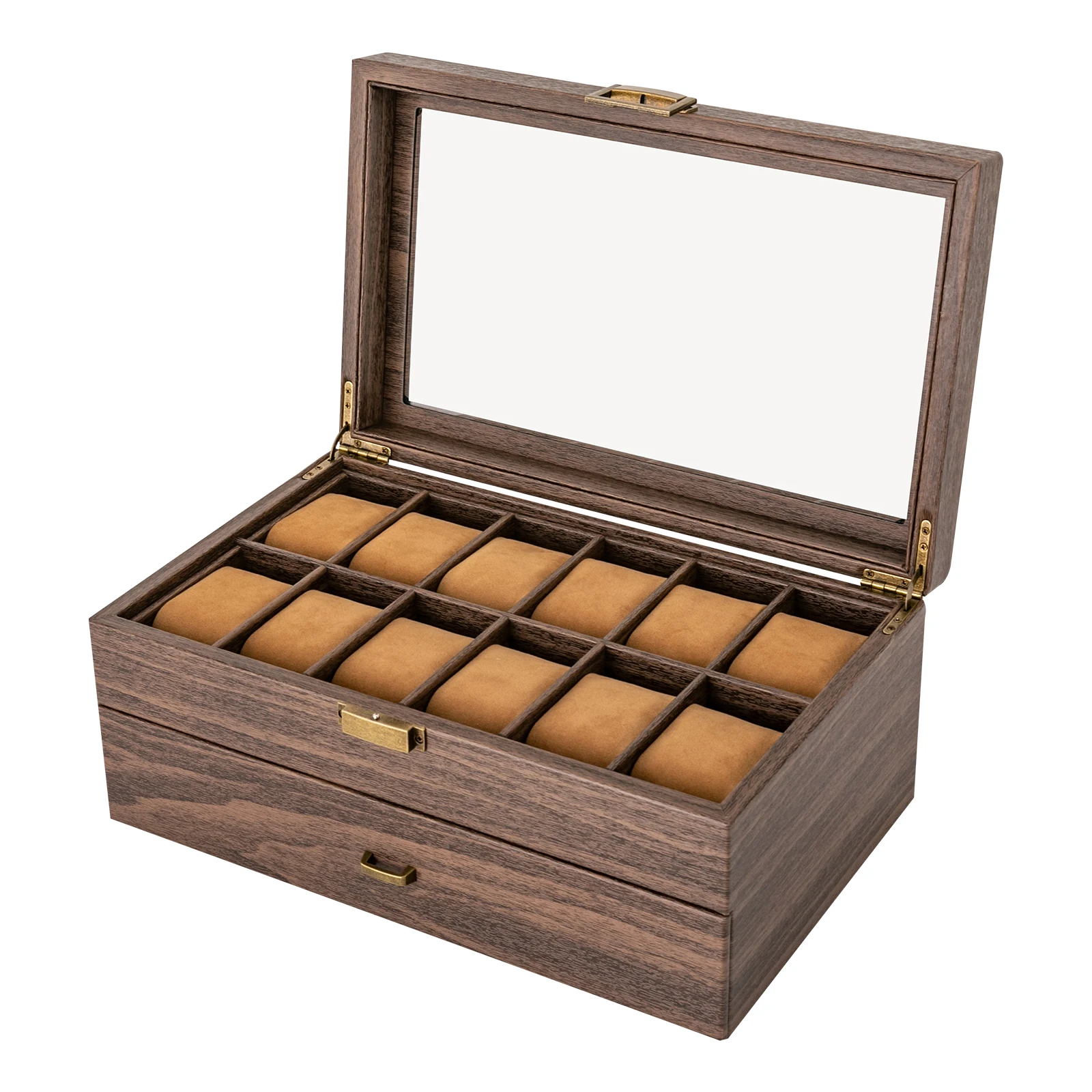
Setting Up Your Watch Winder Correctly
Properly configuring your watch winder is essential for maintaining your timepiece’s accuracy and longevity. Follow this step-by-step guide to ensure your automatic watch receives optimal care.
Initial Preparation
Before placing your watch on a winder, take these important first steps:
Manually wind your watch: Give the crown approximately 20-30 turns (while in the winding position) to establish an initial power reserve. This provides a baseline of energy so the automatic winding mechanism can work effectively.
Set the correct time and date: Ensure your watch displays the accurate time and date before placement. This allows you to easily verify that the winder is maintaining proper function.
Inspect the watch: Check for any signs that your watch might need servicing before committing to long-term winder storage. Significant time deviation, difficulty winding, or unusual noises indicate potential issues that should be addressed.
Proper Watch Placement
How you position your watch on the winder significantly impacts winding effectiveness:
Secure the watch properly: Place your watch on the winding cushion or holder, ensuring it’s snug but not overly tight. The watch should not move independently of the cushion.
Center the watch: Position the timepiece in the middle of the cushion to ensure balanced rotation.
Consider watch weight distribution: Heavier watches with metal bracelets may need extra attention to ensure they’re properly balanced on the cushion.
Programming Your Winder
With your watch properly positioned, now configure your winder settings:
Set the correct TPD: Program the turns per day based on your watch’s specific requirements (refer to the previous brand-specific guide).
Select the appropriate rotation direction: Choose clockwise, counterclockwise, or bidirectional as recommended for your particular movement.
Configure rest intervals: If your winder allows, set intermittent rotation cycles rather than continuous rotation.
4-watch winder units often have individual rotor controls, allowing you to program different settings for each watch in your collection. This is particularly valuable for collectors with diverse timepieces having unique winding requirements.
Optimal Placement and Environment
Where you place your watch winder matters as much as how you set it up:
Avoid magnetic fields: Keep winders away from speakers, refrigerators, and electronic devices that generate magnetic fields, which can affect watch accuracy.
Maintain stable temperature: Place winders in areas with consistent temperature (65-75°F/18-24°C is ideal) away from direct sunlight, heating vents, or air conditioning units.
Control humidity: Excessive moisture can damage both watches and winder mechanisms. Aim for relative humidity between 40-60%.
Minimize vibration: Place winders on solid, stable surfaces away from areas with frequent movement or vibration.
For those considering different storage options, comparing watch boxes vs watch rolls can help determine the best complement to your winder setup for watches not currently in rotation.
Verification and Monitoring
After setting up your winder, verify it’s working correctly:
Check rotation cycles: Observe the winder through several rotation cycles to ensure smooth operation.
Monitor timekeeping: After 24-48 hours on the winder, check your watch’s accuracy. Time deviation may indicate incorrect winder settings.
Make incremental adjustments: If needed, modify TPD settings in small increments until you achieve optimal performance.
By following these steps, you’ll ensure your timepiece receives the proper care it deserves while maximizing the effectiveness of your watch winder investment.
Troubleshooting Common Watch Winder Issues
Even with proper setup, watch winders and automatic watches can sometimes experience issues. Here are solutions to common problems watch enthusiasts encounter:
Watch Stops Despite Being on the Winder
Problem: Your watch stops running even though it’s been on the winder for more than 24 hours.
Solutions:
– Increase TPD setting by 100-150 turns per day
– Try changing the rotation direction (from bidirectional to single direction or vice versa)
– Check if the watch is properly secured on the winder cushion
– Manually wind the watch fully before placing it back on the winder
– Ensure the winder is actually rotating (sometimes motors fail silently)
When to worry: If your watch still stops after trying all these solutions, it may need servicing. A watch that winds properly when worn but stops on a winder often indicates internal issues requiring professional attention.
Watch Running Fast or Slow
Problem: Your timepiece gains or loses significant time while on the winder.
Solutions:
– For a watch running fast: Try reducing TPD (overwinding can sometimes cause timing issues)
– For a watch running slow: Increase TPD slightly
– Check if your winder is near magnetic sources that could affect the watch’s regulation
– Remove from winder and demagnetize if necessary (a watchmaker can perform this service)
When to worry: If accuracy doesn’t improve with setting adjustments, your watch likely needs regulation by a professional.
Inconsistent Winding
Problem: Power reserve fluctuates unpredictably despite consistent winder use.
Solutions:
– Ensure the winder isn’t stopping due to power issues (check batteries or power connection)
– Verify the watch is properly balanced on the cushion
– Try a different cushion size if your watch moves during rotation
– Check if your winder has adequate torque for heavier watches
When to worry: Inconsistent power reserve might indicate internal watch issues such as mainspring problems or winding mechanism inefficiency.
Unusual Noises from the Winder
Problem: The winder makes grinding, clicking, or irregular sounds.
Solutions:
– Check for obstructions in the rotation mechanism
– Ensure the watch isn’t contacting any part of the winder case
– Verify the winder is on a level surface
– Replace batteries if motor seems to struggle
When to worry: Persistent unusual noises usually indicate mechanical problems with the winder itself and may require repair or replacement.
Battery-Related Issues
Problem: Battery-powered winders stop working or have inconsistent operation.
Solutions:
– Replace batteries with fresh, high-quality ones
– Clean battery contacts if corrosion is present
– Consider upgrading to an AC-powered winder for more consistent operation
– Some winders perform better with certain battery brands—experiment if necessary
Understanding watch winder motor specifications can help you diagnose whether your winder has adequate power for your specific timepieces. Higher-quality winders typically have more robust motors that can handle heavier watches and provide more consistent rotation.
Diagnosing TPD Problems vs. Watch Issues
It’s important to determine whether problems stem from incorrect winder settings or issues with the watch itself:
- TPD-related issues typically show gradual improvement when settings are adjusted
- Watch mechanical problems persist regardless of winder setting changes
- If a watch works fine when worn but not on a winder, focus on finding better winder settings
- If a watch performs poorly both on wrist and winder, it likely needs professional service
Remember that automatic watches are complex mechanical devices that occasionally need maintenance regardless of how well you care for them. When troubleshooting fails to resolve issues, consulting with a qualified watchmaker is the best course of action.
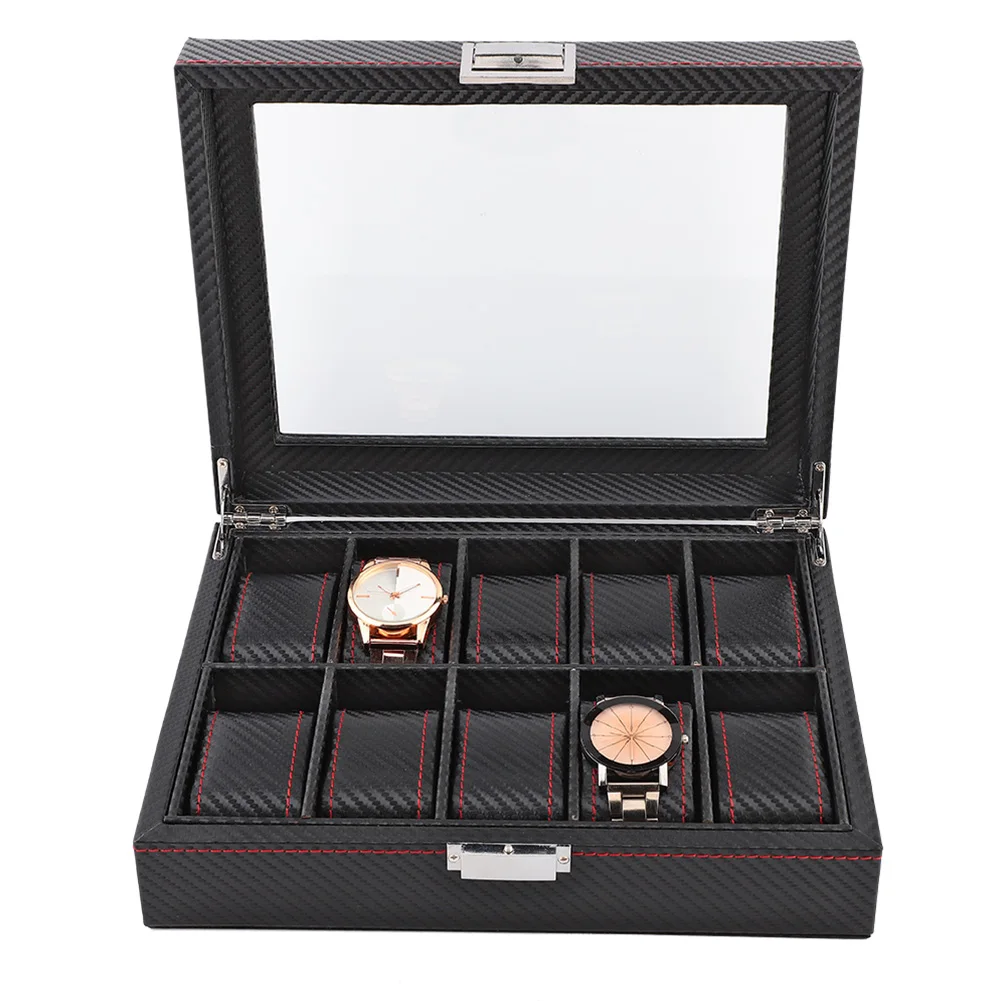
The Benefits of Proper Winder Rotation Beyond Keeping Time
While the primary purpose of a watch winder is to keep your automatic timepiece running when not worn, the benefits of proper rotation settings extend far beyond simple timekeeping. Understanding these advantages helps justify the investment in quality winders and the time spent optimizing their settings.
Maintaining Optimal Lubrication
Automatic watches contain tiny gears and components lubricated with specialized oils and greases. When a watch sits motionless for extended periods:
- Lubricants can settle or migrate from crucial friction points
- Some components may develop increased resistance when restarted
- Inconsistent lubrication can accelerate wear
Proper winder rotation keeps these lubricants evenly distributed throughout the movement, extending the intervals between required servicing and maintaining smoother operation of all components.
Preserving Complex Complications
Sophisticated watches with complications benefit significantly from consistent winding:
- Calendar mechanisms (especially perpetual calendars) remain synchronized
- Moonphase displays maintain accuracy
- Chronograph functions operate more reliably
- Power reserve indicators provide more consistent readings
The more complicated your watch, the more important proper winding becomes for maintaining all functions in perfect synchronization.
Convenience and Ready-to-Wear Access
Beyond mechanical benefits, proper winder rotation offers practical advantages:
- Watches are always ready to wear without resetting
- Rotating between multiple timepieces becomes effortless
- Date and time functions remain accurate between wearings
- For GMT or world time watches, all time zones stay properly aligned
For collectors who enjoy watch storage solutions for small spaces, winders provide the dual benefit of efficient storage while maintaining watch functionality, making them particularly valuable when space is limited.
Display Value While Maintaining Function
Quality watch winders serve both practical and aesthetic purposes:
- Showcase prized timepieces as functional art
- Protect watches from dust while on display
- Maintain watches in their most visually appealing state (with hands in favorable positions)
- Create a focal point for your collection
Protecting the Winding Mechanism
Reducing the frequency of manual winding provides long-term benefits:
- Less wear on the crown and winding stem
- Reduced stress on the crown seals (important for water resistance)
- Minimized risk of over-torquing delicate components
- Extended lifetime for the manual winding mechanism
These benefits combine to make proper winder rotation an essential part of comprehensive watch care. While the initial investment in a quality winder and time spent optimizing settings may seem substantial, the long-term preservation of your timepiece’s value and functionality makes it worthwhile for any serious watch enthusiast.
Automatic Watch Winder, Luxury Watch Winder, Single Watch Box
$307.39 Select options This product has multiple variants. The options may be chosen on the product page4 Watch Winder, 6 Watch Box, Automatic Watch Winder
$512.31 Select options This product has multiple variants. The options may be chosen on the product pageAutomatic Watch Winder, Single Watch Winder, Wooden Watch Holder
$201.76 Select options This product has multiple variants. The options may be chosen on the product pageAutomatic Watch Winder, Leather Watch Travel Case, Single Watch Winder
$146.30 Select options This product has multiple variants. The options may be chosen on the product pageAutomatic Watch Winder, Double Watch Winder, Leather Watch Boxes
$147.60 Select options This product has multiple variants. The options may be chosen on the product pageAutomatic Watch Winder, Double Watch Winder
$206.18 Select options This product has multiple variants. The options may be chosen on the product page
Advanced Winder Features That Optimize Rotation Cycles
Modern watch winders have evolved far beyond simple rotating platforms. Today’s advanced models incorporate sophisticated features that provide optimal care for luxury timepieces while offering convenience and customization options. Understanding these features can help you select the ideal winder for your collection.
Programmable Cycle Patterns
Premium winders now offer extensive programming capabilities:
- Customizable TPD settings in precise increments (often in steps of 50 or 100)
- Adjustable rotation duration (how long each rotation session lasts)
- Programmable rest intervals between rotation cycles
- Custom programs for specific watch brands or movements
These programmable patterns allow you to precisely match your winder’s operation to your watch’s specific needs, rather than selecting from limited preset options.
Sleep Mode and Energy Efficiency
Advanced winders incorporate intelligent power management:
- Timed operation modes that activate only during specified hours
- Sleep cycles that provide extended rest periods (12-24 hours) to prevent excessive winding
- Energy-efficient motors that consume less power while maintaining precise rotation
- Built-in battery backup systems to protect against power interruptions
These features not only conserve energy but also more accurately simulate the natural wearing pattern of a watch, which typically experiences periods of rest when removed overnight.
Multi-Watch Capabilities with Individual Controls
Double watch winders and larger multi-watch systems now offer independent control for each watch position:
- Individual TPD settings for each watch slot
- Separate rotation direction controls for each position
- Independent start/stop timing for different watches
- The ability to deactivate unused positions to save energy
This is particularly valuable for collectors with diverse collections requiring different winding specifications.
Smart Connectivity
The latest high-end winders embrace smart technology:
- Smartphone apps for remote winder control and monitoring
- Customizable programs that can be saved and shared
- Notifications for maintenance or battery replacement
- Usage statistics to optimize winder efficiency
These connectivity features make managing complex winding requirements significantly more convenient.
Silent Motor Technology
Noise reduction has become a priority in modern winder design:
- Japanese Mabuchi motors known for quiet, reliable operation
- Magnetic drive systems that reduce mechanical noise
- Sound-dampening materials within the winder housing
- Vibration isolation to prevent sound transmission to surfaces
Silent operation is particularly important for winders placed in bedrooms or living areas where noise could be disruptive.
Power Source Considerations
Advanced winders offer flexible power options:
- AC adapters for consistent, reliable power
- High-capacity battery options for placement away from outlets
- USB power capabilities for integration with modern power solutions
- Hybrid power systems that switch automatically between sources
The power source you choose affects not only placement flexibility but also the consistency of rotation cycles, with AC power typically providing the most reliable operation for precision winding.
By understanding these advanced features, you can select a winder that not only meets your basic rotation needs but also provides the precise control, convenience, and reliability that your fine timepieces deserve. The investment in these advanced features often pays dividends in improved watch performance and reduced need for servicing.

Frequently Asked Questions About Watch Winder Rotation
Can a watch be overwound on a winder?
Modern automatic watches are designed with a slipping mechanism (often called a bridle spring or mainspring brake) that prevents overwinding. Once the mainspring reaches full tension, this mechanism allows the rotor to continue turning without adding additional tension to the spring.
However, constant winding without rest periods can cause unnecessary wear on components. This is why quality winders use intermittent rotation cycles rather than continuous motion. While true “overwinding” isn’t typically possible, using excessive TPD settings creates unnecessary strain on the movement.
The best practice is to use the minimum TPD setting that keeps your watch running accurately. This reduces wear while maintaining optimal performance.
How long should a watch stay on a winder?
There are two schools of thought on this question:
Continuous Use Approach: Some collectors keep rarely worn watches on winders indefinitely to ensure they’re always ready to wear and to maintain lubrication distribution.
Rotation System Approach: Other enthusiasts use a rotation system where watches spend limited time on winders (typically 1-2 weeks) before being manually wound, set, and stored.
For long-term watch storage protection, the rotation system is generally preferred by watchmakers, as it reduces constant wear on the automatic winding mechanism while still providing periodic movement to distribute lubricants.
Watches worn in regular rotation can be kept on winders between wearings without concern. The key is ensuring proper settings rather than duration.
Do all automatic watches need winders?
No, not all automatic watches require winders. Winders are most beneficial for:
- Watches with complex complications (perpetual calendars, moon phases)
- Timepieces in rotation with several other watches
- Watches that are worn occasionally but should remain ready to use
- Collectors who prefer not to manually set watches each time they wear them
Watches worn daily generally don’t need winders, as natural wrist movement provides sufficient winding. Similarly, watches intended for long-term storage are often better left unwound to reduce unnecessary wear.
Is it better to let a watch stop than use incorrect settings?
Yes, it’s generally better to let a watch stop naturally than to use significantly incorrect winder settings. A stopped watch experiences no mechanical wear, while improper winding can cause accelerated wear or strain on movement components.
If you’re uncertain about the correct settings for your watch, either:
1. Research the specific requirements for your watch model
2. Use conservative settings (650-700 TPD bidirectional)
3. Allow the watch to remain unwound until you can determine proper settings
Modern watches are designed to be stopped and started without harm—it’s improper winding that poses the greater risk.
How often should winder batteries be changed?
For battery-powered winders:
– Alkaline batteries typically last 2-3 months with continuous use
– Premium batteries may last 4-6 months
– Rechargeable batteries generally require charging every 1-2 months
Many collectors using luxury watch storage setups prefer AC-powered winders to eliminate battery concerns entirely, especially for valuable collections. If using battery power, establish a regular battery replacement schedule or watch for signs of slowing rotation, which often indicates weakening batteries.
Can watches with manual-wind-only movements be used on winders?
No, watch winders only benefit automatic (self-winding) watches. Manual-wind-only watches lack the internal rotor mechanism that responds to the motion of a winder. Placing a manual-wind watch on a winder provides no functional benefit and merely subjects the watch to unnecessary movement.
Manual-wind watches should be wound by hand using the crown approximately every 1-2 weeks if being stored for extended periods, to maintain lubrication distribution. Otherwise, they can remain safely unwound until ready to wear.
Final Tips for Maximizing Your Watch Winder’s Effectiveness
To get the most from your watch winder investment and ensure optimal care for your timepieces, consider these final recommendations from experienced collectors and watchmakers.
Maintain Your Winder Regularly
Like your watches themselves, winders benefit from periodic maintenance:
- Clean dust from cushions and winder surfaces monthly
- Check rotation mechanisms for smooth operation quarterly
- Replace cushions that have lost their firmness or shape
- Keep battery contacts clean and free of corrosion
- Periodically verify that programmed settings remain accurate
A well-maintained winder operates more consistently and lasts significantly longer.
Rotate Between Winder and Wrist
The healthiest scenario for most automatic watches is a balance between winder time and actual wear:
- Wearing your watch provides the most natural winding pattern
- Alternating between several watches keeps all mechanisms active
- Even watches in regular winder rotation benefit from occasional wrist time
- This hybrid approach reduces dependency on perfect winder settings
This approach combines the convenience of winders with the benefits of natural wrist motion.
Adjust Settings Seasonally
Your watch’s performance can change with temperature fluctuations throughout the year:
- Lubricants flow differently in winter versus summer months
- Watches may need slightly higher TPD in colder environments
- Humidity changes can affect movement efficiency
- Seasonal wearing patterns may alter your winder needs
Be prepared to make minor TPD adjustments as seasons change, particularly if your winders are kept in areas with temperature fluctuations.
Collection Rotation Strategies
For those with more watches than winder positions:
- Group watches with similar winding requirements
- Prioritize complicated watches for winder positions
- Create a rotation schedule for watches in storage
- Consider budget-friendly watch storage solutions to complement your winders
An organized rotation system ensures all watches receive appropriate care without requiring a winder for every timepiece.
Know When to Bypass Winders
Some situations call for alternative storage approaches:
- Watches needing service should be removed from winders until repaired
- Extremely valuable vintage pieces often benefit from rest rather than constant winding
- Watches with known fragilities might be better manually wound periodically
- During extended travel, secure storage may be preferable to continuous winding
The placement of watch storage in bedrooms or living rooms should consider both aesthetics and functionality. Winders make excellent display pieces but should still adhere to proper environmental guidelines for watch care.
By implementing these final recommendations, you’ll not only extend the life of both your watches and winders but also develop a more intuitive understanding of your collection’s specific needs. The relationship between collector, timepiece, and winder becomes more refined over time, resulting in better-performing watches and more enjoyment from your horological hobby.
